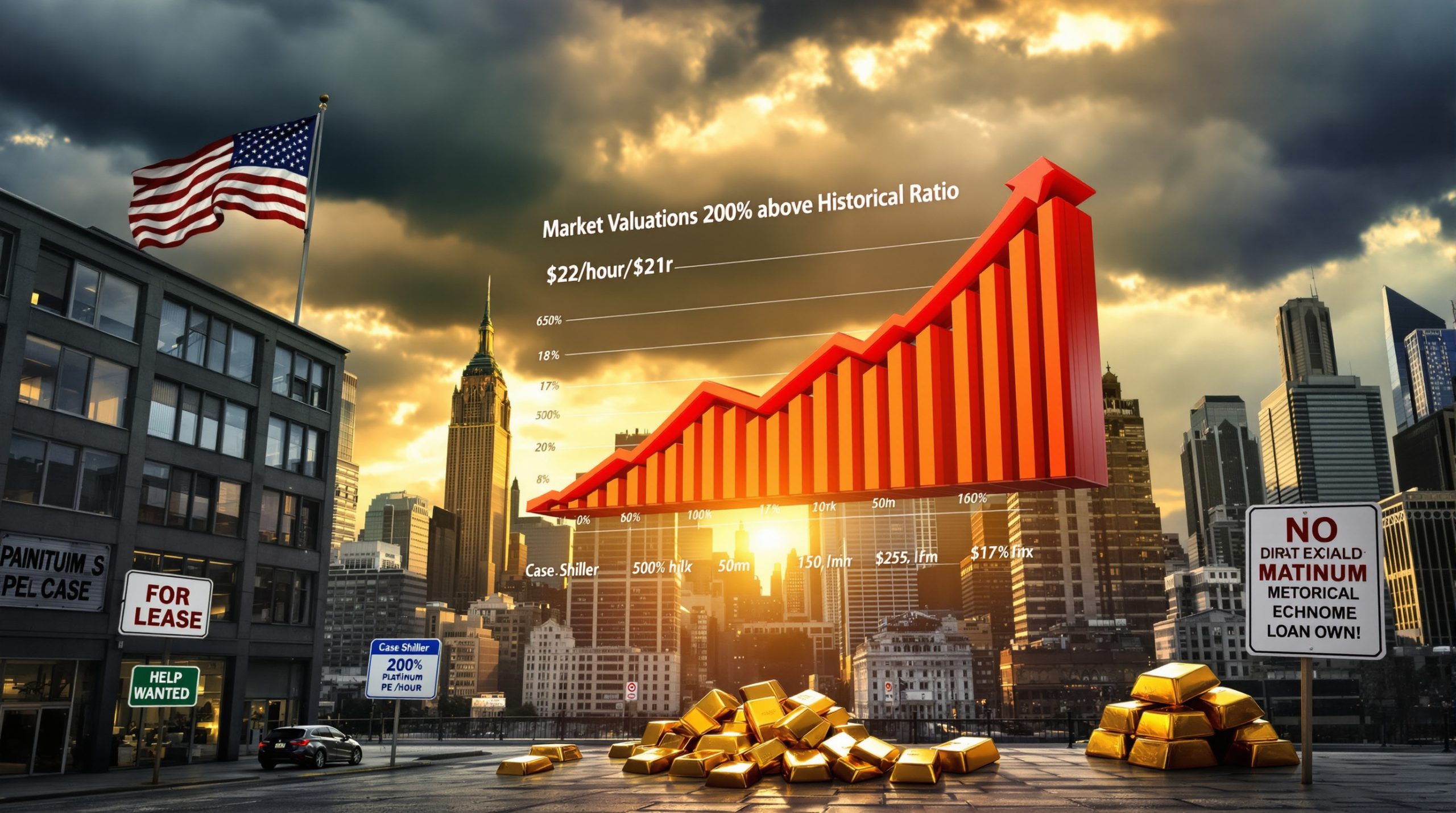What Factors Are Driving Citigroup's Bearish Gold Forecast?
In a surprising turn for gold investors, Citigroup analysts led by Max Layton have projected a significant downturn in gold prices over the coming quarters. Despite gold's all-time high analysis showing a 30% year-to-date increase and reaching an all-time high in April, Citigroup foresees prices falling below the $3,000 per ounce threshold that has become a psychological support level for many market participants.
Key Economic Indicators Influencing the Prediction
Citigroup's bearish outlook stems from several interconnected economic factors that analysts believe will shift investor sentiment away from gold as a safe-haven asset:
- Anticipated economic improvement: Global economic conditions are expected to stabilize, reducing the appeal of gold as a hedge against uncertainty
- Interest rate trajectory: The projected reduction in U.S. interest rates, while typically bullish for gold, may be overshadowed by other factors
- Investment demand weakening: As investor confidence recovers in traditional markets, capital may flow away from precious metals
- Reduced fiscal concerns: Expectations of improved U.S. fiscal management may diminish gold's appeal as protection against government debt issues
"The fundamental shift in macroeconomic conditions expected in late 2025 and into 2026 will likely create headwinds for gold that even central bank purchasing cannot overcome," notes Citigroup's analysis, highlighting the complex interplay of factors driving their bearish forecast.
Citigroup's Price Projections and Timeline
The banking giant has outlined a detailed price projection that includes multiple scenarios, demonstrating the conditional nature of their forecast:
- Base case (60% probability): Gold prices stabilizing above $3,000 in the next quarter before beginning a steady decline
- Bearish scenario (20% probability): More rapid price drops following potential de-escalation of international tariff effects on markets
- Bullish scenario (20% probability): New price highs if geopolitical tensions persist or intensify
The firm's long-term forecast points to gold trading in the $2,500-$2,700 per ounce range by the second half of 2026—a significant decline from the current spot price of approximately $3,388 per ounce (as of June 2025).
"While the current price reflects ongoing geopolitical premium and investor anxiety, our analysis suggests these support factors will gradually diminish, allowing fundamental pressures to reassert themselves in the gold market," according to Citigroup's metals research team.
How Does Citigroup's Forecast Compare to Other Financial Institutions?
The discord among major financial institutions regarding gold's future price trajectory reveals the complexity of forecasting in the precious metals market. Citigroup's bearish outlook stands in stark contrast to several other prominent voices in the financial sector.
Contrasting Bullish Predictions from Major Banks
Goldman Sachs and Bank of America have taken decidedly more optimistic positions on gold's future:
- Goldman Sachs: Projects gold reaching $3,700 per ounce later in 2025, with further appreciation to $4,000 by mid-2026
- Bank of America: Maintains a $4,000 per ounce target for 2026
- JPMorgan: While more moderate, still projects prices remaining above $3,200 through 2026
The fundamental disagreement centers largely on central bank gold-buying demand. Goldman Sachs analysts emphasize continued strong purchasing patterns from global central banks, particularly from emerging economies seeking to diversify reserves away from the U.S. dollar. Citigroup, however, gives this factor considerably less weight in their forecast model.
"Central banks added nearly 1,100 tonnes of gold to their reserves in 2024, and we expect this trend to continue as a structural shift in global reserves management," Goldman Sachs noted in their most recent precious metals outlook—a perspective that fundamentally contradicts Citigroup's position.
Current Market Performance and Context
To understand these divergent forecasts in context, it's helpful to examine gold's current market position:
- Gold has increased approximately 30% year-to-date in 2025
- The precious metal reached an all-time high in April 2025
- Current spot price hovers around $3,388 per ounce (as of June 2025)
- Recent price fluctuations have been primarily driven by Middle East tensions and shifting U.S. policy directions
The market has demonstrated remarkable resilience, with each price dip being met with strong buying interest, suggesting robust support levels. This pattern has reinforced bullish sentiment among many institutional investors, making Citigroup's contrarian view all the more notable.
"The divergence in professional forecasts reflects the unusual confluence of factors affecting gold prices—from geopolitical risk to inflation concerns, central bank policies, and shifting investment patterns," explains market strategist James Chen of Global Metals Advisory.
What Geopolitical and Policy Factors Could Impact Gold Prices?
Gold's status as both a commodity and a monetary asset makes it uniquely sensitive to global events and policy decisions. Several key factors could significantly influence price direction, potentially validating—or invalidating—Citigroup's bearish outlook.
International Tensions and Their Market Effects
Geopolitical uncertainties have historically provided strong support for gold prices, and current global dynamics present several potential catalysts:
- Middle East conflicts: Ongoing tensions in multiple regional hotspots continue to drive safe-haven demand
- Russia-Ukraine situation: Any escalation or resolution could trigger significant market movements
- U.S.-China relations: Trade dynamics and currency competition remain critical factors
- Global energy security: Supply disruptions and price volatility typically boost gold's appeal
The uncertain trajectory of these geopolitical situations adds significant complexity to price forecasting. Citigroup's bearish outlook assumes a gradual de-escalation of international tensions—a projection that many security analysts consider optimistic given current trends.
"Gold's recent price action demonstrates its continued role as a geopolitical hedge, with each escalation driving incremental buying pressure from both institutional and retail investors," notes foreign policy analyst Dr. Rebecca Keller.
U.S. Policy Considerations
Domestic U.S. policies exert outsized influence on gold markets through multiple channels:
- Fiscal policy: Government spending levels and deficit management affect inflation expectations
- Monetary policy: Federal Reserve interest rate decisions directly impact gold's opportunity cost
- Regulatory environment: Changes to banking and financial regulations influence institutional gold holdings
- Trade policy: Tariff implementation or removal alters global economic outlook
The current administration's approach to these policy areas remains a critical variable in Citigroup's forecast. Their base case scenario assumes that fiscal concerns will gradually diminish, reducing gold's appeal as a hedge against government debt and currency debasement.
A table comparing potential policy scenarios illustrates the range of possible outcomes:
| Policy Direction | Likely Impact on Gold | Probability (Citigroup) |
|---|---|---|
| Fiscal restraint | Bearish | 60% |
| Continued stimulus | Bullish | 20% |
| Mixed approach | Neutral | 20% |
What Alternative Investment Opportunities Exist in the Metals Sector?
With Citigroup's bearish outlook on gold, investors may be seeking alternative opportunities within the metals sector. Interestingly, the same analysts predicting gold's decline maintain positive perspectives on several other metals markets.
Bullish Outlook for Industrial Metals
Citigroup's analysis reveals considerable optimism for industrial metals, particularly:
- Aluminum: Strong fundamental support from manufacturing demand and energy transition applications
- Copper: Projected supply deficits due to electrification trends and infrastructure development
- Nickel: Long-term demand growth from battery production and stainless steel requirements
These industrial metals offer potentially superior risk-adjusted returns compared to precious metals in Citigroup's forecast period. The divergence stems largely from their connection to economic growth—the same factor expected to pressure gold prices may simultaneously boost industrial metal demand.
"The transition to renewable energy and electric vehicles alone is projected to increase copper demand by 50% over the next decade," notes mining sector analyst Maria Lopez. "Current production and recycling volumes cannot meet this growth without significant price incentives."
Platinum's Recent Performance
Among precious metals, platinum has emerged as a particularly intriguing alternative to gold:
- Price surge: Over 20% increase within a single week in June 2025
- Technical breakthrough: Achievement of a 10-year price high
- Supply constraints: Ongoing production challenges in South Africa
- Dual demand drivers: Both industrial applications and investment interest
Industry perspectives increasingly position platinum as a "gold substitute" in investment portfolios. The metal's industrial applications in catalytic converters, fuel cells, and green hydrogen production provide fundamental support that pure monetary metals like gold lack.
"Platinum's unique position at the intersection of precious and industrial metals markets gives it particular resilience in changing economic conditions," explains precious metals strategist Michael Williams. "When industrial demand slows, investment interest often compensates, and vice versa."
A comparison of key metals performance year-to-date illustrates the divergent trajectories:
| Metal | YTD Performance (2025) | Key Demand Drivers |
|---|---|---|
| Gold | +30% | Monetary, jewelry, central banks |
| Platinum | +45% | Automotive, industrial, investment |
| Copper | +25% | Construction, electrification, infrastructure |
| Aluminum | +18% | Transportation, packaging, construction |
FAQs About Gold Market Outlook
What is causing the current volatility in gold prices?
Gold price volatility stems from a complex interaction of factors. Geopolitical tensions, particularly in the Middle East, create upward pressure through safe-haven demand. Simultaneously, shifting U.S. foreign policy positions and evolving economic indicators—including interest rate expectations and inflation data—contribute to price swings. This volatility reflects the market's struggle to price in competing narratives about global economic and political stability.
"The gold market is currently processing contradictory signals—strong physical demand, especially from central banks, versus improving economic prospects that typically reduce gold's appeal," explains market analyst Sarah Johnson.
Why do financial institutions have such different gold price forecasts?
The divergence in forecasts reflects different weightings given to key market drivers. Goldman Sachs emphasizes central bank purchasing behavior and persistent geopolitical risks, leading to their bullish $4,000 target. Citigroup, meanwhile, places greater emphasis on macroeconomic factors like economic recovery projections and changing investment patterns. Each institution employs proprietary models with different sensitivity to these variables, resulting in dramatically different conclusions from the same market data.
How might central bank gold purchases influence future prices?
Central bank purchasing has emerged as a crucial support factor for gold prices, with annual acquisition volumes exceeding 1,000 tonnes in recent years. While Goldman Sachs emphasizes this as a structural shift that will maintain upward price pressure, Citigroup considers it insufficient to counterbalance other macroeconomic factors they believe will reduce investment demand. The sustainability of current central bank buying patterns remains a key variable—any significant reduction could accelerate Citigroup's bearish scenario, while continued strong purchasing could validate more bullish forecasted gold trends.
What economic indicators should investors monitor when evaluating gold price forecasts?
Key indicators for gold investors to watch include:
- U.S. interest rate decisions: Higher rates typically pressure gold prices by increasing opportunity costs
- Inflation data: Core PCE and CPI readings influence gold's appeal as an inflation hedge
- Dollar strength: The U.S. Dollar Index (DXY) often moves inversely to gold prices
- Treasury yields: Real (inflation-adjusted) yields have historically shown strong negative correlation with gold
- Central bank purchasing statistics: Quarterly data from the World Gold Council
- ETF flows: Investment fund inflows/outflows reflect changing institutional sentiment
- CFTC positioning data: Futures market positioning indicates speculative interest
Navigating Gold's Uncertain Future
With such divergent professional opinions on gold's price trajectory, investors face significant challenges in positioning their portfolios. Citigroup and future gold market forecasts, contrasting sharply with Goldman Sachs and Bank of America's bullish outlooks, underscores the complexity of the current market environment.
Key Considerations for Investors
Prudent investors should consider several approaches to navigate this uncertainty:
- Portfolio diversification: Maintain balanced exposure across precious metals, industrial metals, and other asset classes
- Dollar-cost averaging: Regular purchases reduce timing risk in volatile markets
- Option strategies: Protective puts or collars can limit downside while maintaining upside exposure
- Technical analysis: Support/resistance levels provide potential entry and exit points
- Fundamental monitoring: Track the key economic indicators outlined above
"The conflicting expert opinions on gold highlight the importance of diversification and individual research," advises wealth manager Thomas Reynolds. "No single forecast should drive investment decisions in such a complex market environment."
Long-term Strategic Approach
Beyond short-term price movements, investors should evaluate gold's role within their broader financial objectives:
- Inflation protection: Despite Citigroup's bearish outlook, gold's historical correlation with inflation remains relevant
- Currency debasement hedge: Ongoing global monetary expansion supports gold's monetary role
- Crisis insurance: Allocation to gold provides portfolio protection during extreme events
- Supply constraints: Mine production growth continues to slow, creating potential long-term support
For those concerned about Citigroup's bearish projection, industrial metals and platinum offer alternative exposure with potentially stronger fundamental support. Copper price insights reveal its critical role in electrification and platinum's dual demand drivers provide compelling investment strategies regardless of gold's trajectory.
"The future gold market will likely be characterized by increased volatility as competing narratives drive price action," concludes veteran trader Robert Chen. "Success will come not from picking the correct forecast, but from building a resilient strategy that can thrive in multiple scenarios."
Want to Invest in the Next Major Mineral Discovery?
Turn complex ASX announcements into actionable investment opportunities with Discovery Alert's proprietary Discovery IQ model, which delivers real-time notifications of significant mineral discoveries before the broader market reacts. Explore why historic discoveries can generate substantial returns by visiting Discovery Alert's dedicated discoveries page and begin your 30-day free trial today.




